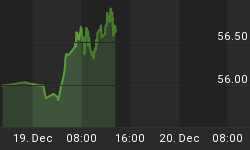Two weeks ago we said to look for one final rally in the S&P 500 as long as the 1160 level held up. It is not lost on us that once again stocks show they can only rally if long term yields and the dollar are not rising. But this trend should soon come to an end.
Below we feature our "investment nirvana" theme that depicts when investors fear neither stock market losses nor inflation. We represent this by dividing the T-bond by the Vix. Recall that in December 2004 this ratio tested its all time high of 10 seen exactly ten years ago in December 1993. Importantly, the previous top coincided exactly with the Fed's rising interest rate cycle that began in February 1994 after having held rates at 3.0% for 17 months following a rate cutting cycle that began in July 1990 at 8.0%.
Note how there was a final surge in T-bonds as the steepening yield curve reversed direction and began to flatten. Then, when the ratio between the 30-year bond yield and the 3-month money market fell to 2 (30-year at 6% and money market at 3%) the bond market peaked and began to head sharply lower. This coincided with a peak in the Bond/Vix ratio as well. Interestingly, the exact same set up is occuring now in the Treasury bond.

* When the yield curve peaks many traders buy long dated bond and sell shorter maturity bonds. This was the primary reason long bonds rose in 1993 while short-term bonds fell.
Similarly, the T-bond to Vix ratio has retested its all time high of 10 while the yield curve has flattened over the past twelve months. During this time the long bond has rallied while the market anticipates higher rates and has pushed up the the 3-month from 0.9% to 2.46% in less than a year.
The only difference between now and then is that the yield curve peaked and headed sharply lower in October 1992, fourteen months before the Fed first raised rates to 3.25% in February 1994. This time the yield curve did not begin to flatten until the Fed's first rate hike in June 2004.
If we focus only on the turn in the yield curve itself we see that the eight-month rally in T-bonds is identical to the 1993 rally in the sense that it is mainly a result of traders playing the yield curve after it peaked and began to flatten out.
With a Fed funds rate of 2.5% still extremely accommodative there will be ample room to raise short-term rates but little room left for traders to play the curve. Therefore, we should see a substantial decline in the long end of the bond this year as this artificial support for US long-term debt subsides. This provides an excellent opportunity for those bearish on long bonds.

Note: You can read our strategy report on US bonds in this month's issue of Futures magazine.
Moreover, reall that our research report from last week showed that the ratio of shorts to longs held by commercial hedgers, aka smart money insiders, in the 30-year bond reached an all time high in December, eclipsing the high seen in 1998 before bond prices collapsed and occured in conjunction with the all time high in the bond to Vix ratio.

Therefore, we feel that this bond rally is very susceptible to a spill as the yield curve ratio has flattened to 2 - exactly the same point when bonds prices peaked in 1993.
Recent Testimonial for FX Money Trends: "I find FX Money Trends' work extremely helpful. As a macro hedge fund manager I base my success on ideas generated both internally and through external research services: FX Money Trends and its founder Jes Black constantly provide ideas which are based both on very clever fundamental and technical analysis and research. FX Money Trend's intellectual independence makes their ideas precious, never obvious nor "late." - Francesco Clarelli, Italy.















